
Once every century, a hoary old castle seems to arise from nowhere. In its shadow come devastation and wickedness. It is the eternal home of the most terrifying fiend ever to wear a cape, the Prince of Darkness himself… Dracula.
It’ll take one pissed-off man with a whip to defeat the Dark Prince. No, I don’t mean Indiana Jones.

Castlevania was released as Akumajo Dracula for the Famicom in 1986, coming to the American NES in 1987 and hitting Europe in early ’88. The game is considered by many to be a classic on par with Super Mario Brothers or Legend of Zelda. One of the most memorable and entertaining titles Konami ever released for any platform, the game spawned a lengthy saga spanning from the 8 bit era to the modern age. There will be a noticeable bias throughout this article, dear reader; you see, there is no denial on my part that the Castlevania series is my absolute favorite. I waited patiently until now, and I’m very happy to be discussing the flagship title in the series now.

While the plotline thickens further down the line of this game series, the story of the original is pretty simple. Dracula’s castle as resurfaced, and you, Simon Belmont, must put the King of the Vampires back to rest by finding him in the castle’s tower. What no one told you (but you probably knew anyway) is that Drac’s invited all his buddies over and thrown a sort of perpetual monster party on the castle grounds. Thankfully, you’ve got some firepower in the form of a mystical whip. Called Vampire Killer, this whip has been passed down the Belmont line for the express purpose of gate-crashing Dracula’ s shit and sending him back to oblivion.

The Belmont family also has a strange run of luck when it comes to whipping candles; instead of getting wax everywhere, they tend to uncover little hearts and sometimes even powerups. The hearts act as “Ammunition” for a set of sub-weapons that will help you cleave a path through the denizens of the castle. These include a high-arcing axe, a cross-like boomerang that you can use to double-hit an enemy, and holy water that (if placed optimally) can really tear a monster a new one by doing continuous harm. There is another sub-weapon, a stopwatch that will halt all enemies in their tracks for a few seconds… except for the more powerful ones. In addition to the weapons, you can also find Roman numerals “II” and “III” which allow you to throw more sub-weapons at a time. Combining this with the holy water is actually devastating to certain bosses; you can use multiple holy waters to freeze them in ongoing agony while also spanking them with the whip. This is also a lot of loot lying around – bags of money, even crowns and stuff. Some of it’s in the candles, and some of it’s hidden. If you get badly hurt, try hitting the walls. Dracula left you some meat in there. Not only is this true, but the meat also replenishes a good chunk of lost health. Unfortunately, it is rare and scattered throughout the game in walls.

And if ever a set of enemies would have a gamer hitting the walls, it would be the ones living inside Dracula’s nightmarish castle. There are your standard bats and skeletons and even some mermen as you traverse the first set of rooms, and they’re even guarded by a gigantic vampire bat, but it gets even more frustrating later on. There are some types, like the Medusa heads, that just never stop flying at you in a wavy, hard-to-dodge pattern. Little hunchbacks that jump around like total assholes, skeletal dragons that grow out of walls, incredibly durable suits of animated armor that hurl axes… it gets so thick eventually that giant birds are dropping the little hunchbacks on you from above.
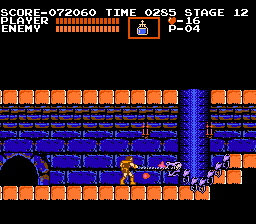
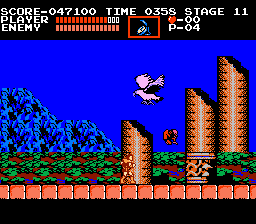
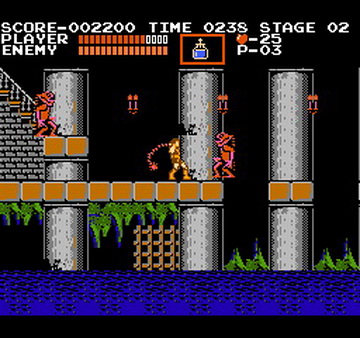
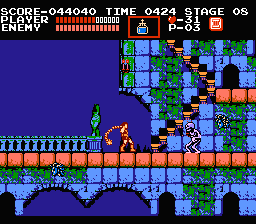
Above: The gallery of pain. Click on an image to see a slightly bigger version.
Some of the bosses are a joke, but you still have to watch yourself. Sometimes it’s a matter of skipping sub-weapons you find to keep the right one equipped. For instance, any boss that flies can be nailed good with holy water; wait until it flies near a floor, then cover the floor in holy water while whipping away. This is harder to pull off on the Grim Reaper than it is on Medusa, because the Grim Reaper’s constantly surrounded by flying scythes. The first floor’s giant bat guardian is easier if you use the axe, since it’s usually above you. Some of the other ones, like the twin mummies or Frankenstein’s Monster (paired up with one of those SON OF A BITCH hunchbacks), will give you a pulse-pounding challenge regardless of what you bring to the party. As for Old Drac himself, his first form isn’t too hard. He teleports from one end of the room to another, throwing small fireballs toward you. Once you knock his block off, he mutates into a surprisingly scary-looking demon and leaps at you until you finish him off. You are then treated to a parody credit-roll with puns on the names of famous horror actors.
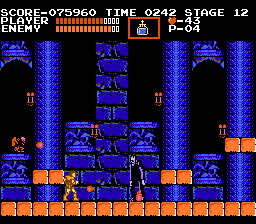
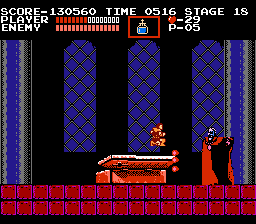
The graphics in Castlevania aren’t anything groundbreaking, but they’re very good. There’s not much guessing what anything’s supposed to be, and while the color depth isn’t much to write home about, the enemies and background are detailed enough to bring about that creepy horror atmosphere. What really stands out Castlevania (both this game and the whole franchise) is the music. Kinuyo Yamashita and Satoe Terashima composed the score, which is considered by VG music nerds to be an example of how to write a brilliant game soundtrack. “Heart of Fire” is probably my favorite track, but every piece of music in the score is a work of art. This would go on to ring true (to varying degrees) throughout the series.
Two sequels were made for the NES: Castlevania II: Simon’s Quest in 1987, and Castlevania 3: Dracula’s Curse in 1989. They arrived in the USA in ’89 and ’92 respectively. Both games stayed true to the original in terms of gameplay, but contained expanded concepts that made the game nonlinear or added RPG-style elements to gameplay. As most fans know, the series went on to span several generations of console, including the amazing games Aria of Sorrow and Dawn of Sorrow for Nintendo’s newer handhelds. These feature the near-future protagonist Soma Cruz as he fights to put Dracula’s castle back inside an eclipse. These games’ play style is modeled directly after the PS1 title Symphony of the Night, another milestone in the Castlevania series where you play Dracula’s son Alucard.
But those we will save for another dark and stormy night (soon)! I give the original Castlevania eight stars out of ten. It’s a classic, it’s got just the right difficulty level to be truly engaging, and there’s nothing like beating Dracula’s head off with a whip.
Here’s a f*cking insane speed run.
Here’s a great article on the chronological storyline of the whole series.
Here is a great place to learn all kinds of stuff about the games, the series, and anything related to the franchise.




